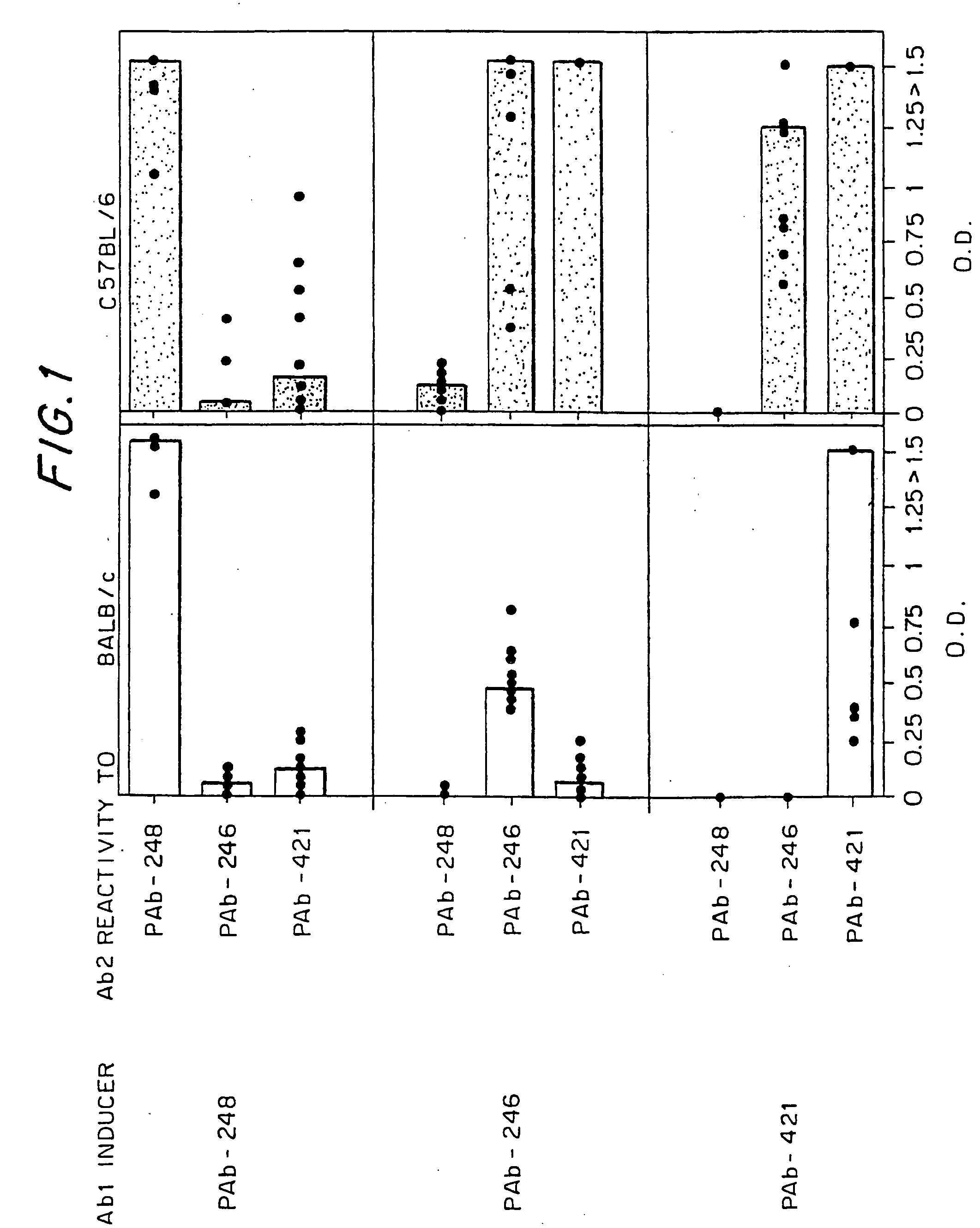Treatment of systemic lupus erythematosus by down-regulating the autoimmune response to autoantigens
a technology of autoantigens and autoimmune disorders, applied in the field of systemic lupus erythematosus by downregulating the autoimmune response to autoantigens, can solve the problems of not being able to define the “natural” antigens of idiotypic antibodies, and not being generally accepted explanations for the prevalence of anti-dna antibodies in autoimmune disorders, etc., to achieve the effect of increasing the immunogenicity of t cells
- Summary
- Abstract
- Description
- Claims
- Application Information
AI Technical Summary
Benefits of technology
Problems solved by technology
Method used
Image
Examples
example 1
Induction of SLE
Materials and Methods
Mice and Antibodies
[0107] Female mice of the BALB / c or C57BL / 6 strains were obtained from the animal breeding facilities at the Weizmann Institute of Science, Rehovot, Israel, and used at the age of 8-10 weeks. Mice were immunized with anti-p53 antibodies PAb-246, PAb-248, or PAb-421, which were purified from ascitic fluid by Protein A affinity chromatography (Sigma, Rehovot, Israel). Fifty micrograms of antibody emulsified in complete Freund's adjuvant were injected into the hind footpads. The mice were boosted twice at three-week intervals, subcutaneously in the flank with 20 micrograms of the antibodies in incomplete Freund's adjuvant. Sera were obtained ten days after the first boost. For detection of anti-histone antibodies, mice were bled again two weeks after a second boost. Female MRL / MpJ-Faslpr mice were obtained from Jackson, at the age of six weeks and bled twice, at the ages of 9 and 19 weeks.
Recombinant p53 and p53 Peptide Epit...
example 2
Idiotypic Recognition of PAb-421 in a Mouse Strain that Develops SLE Spontaneously
[0130] To learn whether an idiotypic recognition of the C-terminus of p53 might also play a role in the spontaneous development of SLE, MRL / MpJ-Faslpr, a strain that develops SLE spontaneously, was examined for the presence of antibodies to p53 and PAb-421. As can be seen in FIG. 6, these mice, 15 spontaneously on their way to SLE, make rising titers of antibodies to p53, to the p53 peptide epitope of PAb-421, and to PAb-421, but not to other anti-p53 antibodies (PAb-248, PAb-246, PAb-240). Thus, it appears that the same idiotypic network that was associated with SLE induction in the BALB / c mice was also operative in the spontaneous disease development of the MRL / MpJ-Faslpr mice.
[0131] As noted above, the immunization of BALB / c mice to two different Ab1 antibodies that each recognizes one of the two different DNA-binding domains of p53 resulted in idiotypic immune responses that included anti-DNA imm...
example 3
Isolation of Monoclonal Antibodies that Mimic the Carboxy Terminal Domain of p53 and Bind Damaged DNA
[0136] To generate such antibodies, BALB / c mice were immunized with PAb-421 and selected hybridomas producing anti-idiotypic antibodies that bound PAb-421 and could also bind DNA were isolated.
[0137] Two monoclonal antibodies, IDI-1 and IDI-2, could be isolated which had been selected for idiotypic binding to PAb-421 and their reactivities were determined. As shown in FIG. 7, both showed specific reactivity to PAb-421 and to DNA, single-stranded or double-stranded. No reactivity was found to mouse antibodies other than PAb-421, like R73. The binding of IDI-1 and somewhat less of IDI-2 to single-stranded DNA was markedly enhanced after gamma-irradiation of the DNA, depending on the radiation dose absorbed by the DNA. This is remarkable, since p53 also shows preferential binding to DNA damaged by gamma-irradiation (Reed et al, 1995), as well as to single-stranded DNA ends (Selivanova...
PUM
| Property | Measurement | Unit |
|---|---|---|
| Fraction | aaaaa | aaaaa |
| Fraction | aaaaa | aaaaa |
| Fraction | aaaaa | aaaaa |
Abstract
Description
Claims
Application Information
 Login to View More
Login to View More - R&D
- Intellectual Property
- Life Sciences
- Materials
- Tech Scout
- Unparalleled Data Quality
- Higher Quality Content
- 60% Fewer Hallucinations
Browse by: Latest US Patents, China's latest patents, Technical Efficacy Thesaurus, Application Domain, Technology Topic, Popular Technical Reports.
© 2025 PatSnap. All rights reserved.Legal|Privacy policy|Modern Slavery Act Transparency Statement|Sitemap|About US| Contact US: help@patsnap.com



